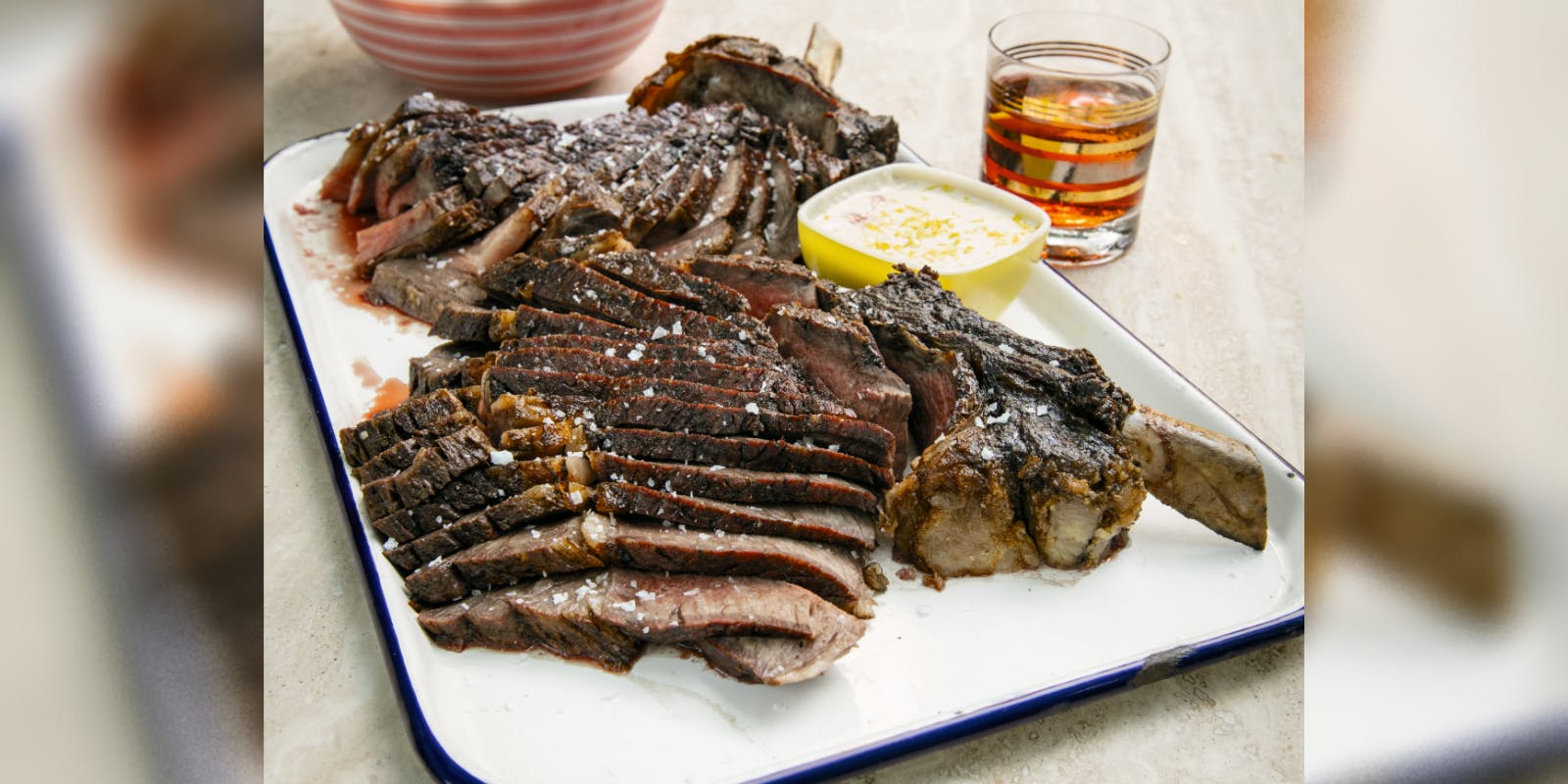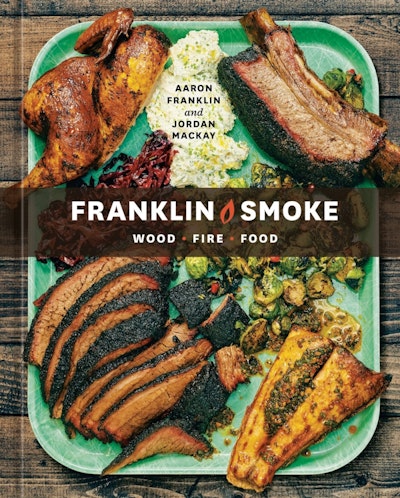A staple of French cookery, côte de boeuf is immensely versatile.
The term basically refers to a bone-in rib-eye steak, as we call it here in the US when it’s just one bone. It’s typically cut thick in France and meant to feed two people. It could also be known as a (very short) standing rib roast. But rib roasts are usually cooked in the oven, and here I use a two-bone rib steak to create a sort of hybrid steak–prime rib dish. You could also use a thick-cut, single bone rib eye, but it would cook faster. The pleasures of prime rib roast and grilled steak converge in one piece of meat: plenty of tender interior meat is matched with a thick, crunchy crust that supplies the ideal contrast of smoke, salt, and caramelization. Plus, one big rib steak is plenty to feed two to four people, making for a lovely presentation that can be shared family-style.
Any good butcher can prepare a two-bone rib steak for you, though it’s wise to order it a day or two in advance to make sure he or she can cut it to your preference. If the steak has an especially thick outer layer of fat, ask the butcher to trim some off to avoid flare-ups. You may also want to ask that the steak be tied with butcher’s twine so it maintains its form during a fairly lengthy cook, though I usually skip this step. Prep involves little more than dry brining with salt.
Côte de boeuf is a natural for the firepit, which allows you to cook directly, indirectly, and with a bit of smoke—all from fresh wood coals. The thickness of the cut demands a relatively long cook and gives you lots of flavor from the fire. This is basically a low-pressure two- to three-hour cook—the kind of thing you do while waiting for friends on a Saturday afternoon. Ideally, cook it slowly to get even cooking throughout. But because it is steak, you can also cook over higher heat if you need to speed things up.
Cook time: 2 to 3 hours
Serves 4 to 8
Ingredients
The meat
- Kosher salt
- 2 two-bone rib steaks, trimmed and tied
- Water, beef stock, or vinegar for spritzing
- Melted tallow or grapeseed oil for coating
- Horseradish Cream Sauce (recipe follows) for serving
- Grapeseed oil for the grate
Horseradish cream sauce
Makes 1 ½ cups
- 1 cup / 240g sour cream
- 2/3 cup / 140g prepared horseradish
- 2 tablespoons / 28g champagne vinegar
- Grated zest of 1 lemon
- Fine sea salt
Method
Liberally salt the exterior of the steaks and set them on a baking sheet. Let the steaks air-dry, uncovered, in the refrigerator for 24 to 36 hours.
Build a firepit fire, burning down six to eight logs to create a nice coal bed, then maintain another couple of logs burning on the side to supply coals. When it’s time to start cooking, clear the burning logs off the coal bed so you have just coals to cook over. The logs can continue to burn on the side. Because of the length of time that these steaks cook, they are best done over a medium-to-low-heat coal bed with the grate set eighteen to twenty-four inches above the coals. Oil the grate.
While the first logs are cooking down, remove the meat from the fridge to temper it a bit before putting it on the fire.
Stand the steaks vertically on the bone on the grate. This heats up the bone and begins the process of slowly cooking the adjacent meat. After the bone is browned, turn the steaks onto a side and let them go from there. Don’t turn the spinalis side (the rib-eye cap or muscle that runs along the outside of the steak, opposite the bone) to face the flames from the burning logs. The spinalis is the most tender and flavorful part of the rib eye. It will always cook past rare, but it’s good to protect it from too much heat so it retains its moisture.
Keep the steaks over low to medium heat on the cooler areas of the grate. Move them around fairly frequently, flipping them at the same time. While you’re flipping, also keep a spray bottle full of water handy to spritz the steaks, cool the sides, keep the crust from drying out too much, and prolong the cook. Slowly build a crust on the side facing the heat and then flip the steaks to let that side cool while the other side cooks. Do this repeatedly until a digital thermometer inserted into the side of each steak at the middle reads 110° to 112°F (about 43°C to 44°C). At that moment, pull the steaks off the grate.
Allow the steaks to rest while you add some wood to replenish the coal bed until it is raging hot. After the steaks have rested no less than 30 minutes and for up to 1 hour—however long it takes to get the fire really hot again—gently coat the steaks in the tallow and throw them back on the grate for a couple of minutes on each side, until the crust gets nice and sizzling again. Remove the steaks from the heat.
When the steaks are cool enough to hold, it’s time to slice and serve. Slice between the bones so you have two rib-eye steaks. Slice the meat off the bone, leaving the bone in place, thus retaining the shape of the original steak. Then cut across the steaks, fanning from the bone to obtain nice long strips. Arrange the slices on a platter and include the bones. Serve horseradish sauce alongside.















